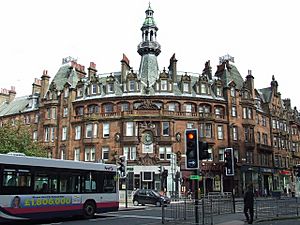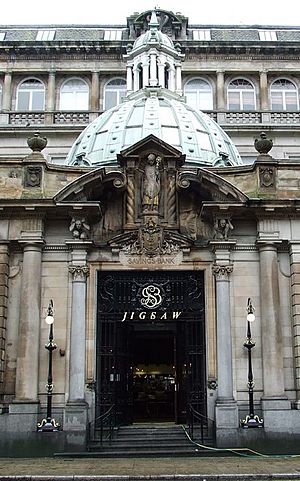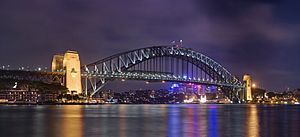John James Burnet facts for kids
Quick facts for kids
John James Burnet
|
|
|---|---|
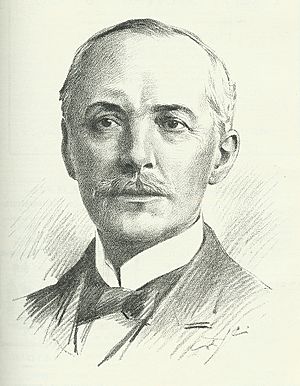
Sir John James Burnet
|
|
| Born | 31 May 1857 Blythswood Hill, Glasgow, Scotland
|
| Died | 2 July 1938 (aged 81) Colinton, Edinburgh, Scotland
|
| Nationality | Scottish |
| Citizenship | United Kingdom |
| Alma mater | École des Beaux-Arts, Paris |
| Occupation | Architect |
| Awards | FRIBA; Knighthood; RSA; École des Beaux-Arts bronze medal (1914); École des Beaux-Arts gold medal (1922); Royal Gold Medal (1923 & 1938); RA (1925); |
| Practice | John Burnet and Son; later Burnet, Tait & Lorne |
| Buildings | Athenaeum Theatre, Glasgow (1891); King Edward VII Gallery, British Museum, London (1905); Unilever House, London (1933) |
| Design | Neoclassical, Art Deco, Streamline Moderne |
Sir John James Burnet (born May 31, 1857 – died July 2, 1938) was a famous Scottish architect. He designed many important buildings in Glasgow and London. His father, John Burnet, was also an architect. John James later joined his father's company. This company became very important in British Modern architecture in the 20th century.
Contents
Who Was John James Burnet?
John James Burnet was born in Blythswood Hill, Glasgow, on May 31, 1857. He was the youngest of three sons. His parents were architect John Burnet and Elizabeth Hay Bennet. His family belonged to the Congregationalist faith. John James went to school in Glasgow at the Collegiate School, Western Academy, and Blairlodge School.
Studying Architecture in Paris
John James first trained for two years in his father's office. His parents wanted him to study at the Royal Academy Schools. But his teacher, Richard Phené Spiers, suggested he go to the École des Beaux-Arts in Paris.
His parents were a bit worried about sending him to a Catholic country. Paris had also seen some political trouble recently. But in 1872, he started studying there. He learned from Jean-Louis Pascal, who was Spiers' old teacher. John James learned very quickly. By 1876, he earned his degree in architecture and engineering. He also worked as an assistant to François Rolland. While in Paris, he became lifelong friends with Henri Paul Nénot.
Starting His Career as an Architect
After his studies, Burnet traveled around France and Italy. He came back to Glasgow in late 1876. He helped his father finish the front of the Union Bank of Scotland building. In 1878, Burnet won a competition to design the Fine Art Institute in Glasgow. This was his first big project on his own. The design needed to mix 'Greek with modern French Renaissance' styles. Greek Revival architecture was very popular in Glasgow then. The building also had sculptures by John Mossman.
Burnet didn't win the competition to design the Glasgow City Chambers in 1882. But his design for the Clyde Navigation Trust building (1882–86) made him successful. This happened even during a time when the economy was slow.
In 1881, Burnet became an Associate of the Royal Institute of British Architects (ARIBA). In 1882, his father took him on as a partner. Their company was renamed John Burnet & Son. Later, John Archibald Campbell joined the company in 1886. He had also studied in Paris. The company's name then became Burnet Son & Campbell.
The "Burnet Baroque" Style
John James's father retired around 1889 or 1890. John James Burnet and Campbell then took the company in a new direction. They looked to London's architecture scene for new ideas. They also wanted to win more national design competitions. Their new style was very different and not always popular. Their designs for the Central Thread Agency in Glasgow and the North British Hotel in Edinburgh were not chosen.
Their first success with the new style was the Glasgow Athenaeum Theatre (1891–1893). This was a tall building, like American ones, in a Neo-baroque style. This style was similar to that of other famous architects like John Belcher. John James Burnet traveled to Italy in 1895 to learn more about Baroque architecture.
The "Burnet Baroque" style became very popular. Other architects quickly started using this new Neo-Baroque look. By 1900, it was the common style for buildings in Glasgow. It even influenced the winning design for the North British Hotel. In 1896, Burnet entered a competition to design the Glasgow School of Art. He didn't win, and the job went to a young designer named Charles Rennie Mackintosh.
In 1896, the Burnets visited the United States. John James was very inspired by American architecture. He started designing buildings with lower profiles and wide roofs. These included churches and public buildings across Scotland. Examples are Dundas Memorial Church in Grangemouth (1894) and the Public Library in Campbeltown. The influence of American building methods showed in Burnet's work. This was especially clear in his design for McGeoch's Department Store (1905–1910). This building had strong vertical lines. You could see the building's structure on its outside.
| Dates | Company Name | Partners |
|---|---|---|
| 1882–1886 | John Burnet and Son | John Burnet, JJ Burnet |
| 1886–1897 | John Burnet, Son and Campbell | John Archibald Campbell |
| 1897–1919 | John Burnet and Son | went back to old name after Campbell left |
| 1918–1930 | Sir John Burnet & Partners | Thomas Smith Tait and David Raeside |
| 1919–1920 or 1921 | John Burnet, Son & Partners | Thomas Harold Hughes |
| 1921–1940 | Burnet, Son & Dick | Norman Aitken |
| 1930-c. 1949 | Sir John Burnet, Tait & Lorne | JJ Burnet, Thomas Smith Tait and Francis Lorne (later also Gordon Thomas Tait) |
In the same year, John James Burnet became a Fellow of the Royal Institute of British Architects (FRIBA). He was also chosen as President of the Glasgow Institute of Architects. In 1902, Burnet hired a promising young architect named Thomas Smith Tait as his assistant. Tait later became a partner in the company. He went on to be one of the most important architects in the British Modern architecture movement.
Designing for the British Museum
Burnet and Campbell had not won any big competitions in England as partners. But after Campbell left, Burnet started to work on projects outside Scotland. In 1903–1904, the Office of Works chose Burnet to design the Edward VII Galleries. These galleries were for the British Museum in London.
In 1905, Burnet opened a London office. He took the young Thomas Tait with him. Burnet's first plans were very grand. He wanted to expand the Museum on all four sides. This would have meant tearing down buildings in Bloomsbury. He imagined a Parisian-style British Museum Avenue. But only the Edward VII Galleries were built because there wasn't enough money. Construction lasted from 1906 to 1914. In 1910, King Edward VII died. The Edward VII Galleries were opened by King George V and Queen Mary in 1914.
This important work on the British Museum brought new jobs for Burnet's company. These included the General Buildings in Aldwych (1909–11) and the Kodak Building on Kingsway (1910–11). The Kodak project was a big step for the company. The American client, George Eastman, liked modern designs. He rejected several of Burnet's ideas. He finally chose a design by Thomas S. Tait. This design became a model for the company's future projects.
In 1907, Norman Aitken Dick joined the partnership. Around this time, the Glasgow office designed some of its most important buildings. These included the Alhambra Theatre Glasgow, which was an early example of a steel-framed building. He used this same construction method for the Kodak Building in London. They also designed the Sick Children's Hospital at Yorkhill. Burnet continued to visit the United States in 1908 and 1910. He studied the design of warehouses, hospitals, museums, and galleries.
Burnet was given the title of "Sir" (knighted) in 1914. This was for his work on the British Museum galleries. He also won a bronze medal from the Paris Salon. He was elected to the RSA. In 1921, he became an ARA. He received the Paris gold medal in 1922. Burnet also helped start the Royal Incorporation of Architects in Scotland.
Working Between the World Wars
The start of the First World War was a difficult time for Burnet's company. During this period, Thomas Tait left to work in America after a disagreement. After the war, the London office started getting new jobs again. This included work on finishing the Selfridges department store on Oxford Street. The Imperial War Graves Commission also asked Burnet's company to design war memorials. These were in Gallipoli, Palestine, and Suez (1919). Burnet played a big part in designing these memorials. He also worked on Adelaide House, London Bridge.
However, his health was getting worse. Stress from the war, professional disagreements, and financial problems in the Glasgow office made it hard for him to work. Thomas Tait came back to the company after they settled their differences. Tait started taking a leading role. He worked on the Daily Telegraph Building and Lloyds Bank on Cornhill. Burnet himself worked on redesigning the Unilever House project. But mostly, he acted as a consultant and went into semi-retirement.
Burnet received the Royal Gold Medal in 1923. He was elected to the RA in 1925.
Retirement and Passing Away
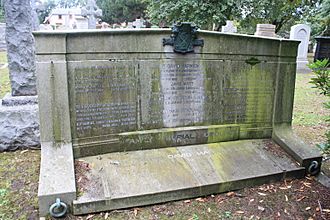
Until 1935, he lived at Killermont. This was his Arts and Crafts style house in Rowledge, Surrey. He then bought a smaller home called Woodhall Cottage in Colinton, Edinburgh. Even though he kept up with the work at the Burnet Tait & Lorne office, he wasn't happy in retirement. He passed away at home on July 2, 1938. His remains were cremated. His ashes were buried in his father-in-law's grave at Warriston Cemetery.
The Burnet Tait & Lorne company continued to do well after his death. Under the leadership of Thomas Smith Tait, it became a very important force in Modern Architecture.
Family Life
In 1886, John James Burnet married Jean Watt Marwick (1864–1949). She was the daughter of Sir James David Marwick.
Famous Buildings and Projects
Here are some of the important buildings he designed that are still standing:
- Gardner Memorial Church, Brechin (1896)
- Clyde Navigation Trust (Clydeport) Building, Glasgow (1883 and 1905)
- Barony Church, Glasgow (1886)
- John McIntyre Building, University of Glasgow (1886)
- Charing Cross Mansions, Charing Cross, Glasgow (1891)
- Athenaeum, 8 Nelson Mandela Place, Glasgow (1886)
- New Athenaeum Theatre, 179 Buchanan Street, Glasgow (1891)
- Royal Faculty of Physicians & Surgeons of Glasgow (1892)
- Glasgow Savings Bank, 177 Ingram Street, Glasgow (1896)
- Albany Chambers, Sauchiehall Street, Glasgow (1896)
- King Edward VII Gallery, British Museum, London (1905)
- RW Forsyth's Department Store, Gordon Street, Glasgow (1896 and 1906)
- RW Forsyth's Department Store, Princes Street, Edinburgh (1906)
- Broomhill Trinity Congregational Church, Glasgow (1907)
- Kodak, Kingsway, London (1909)
- General Accident Assurance, Aldwych, London (1909)
- Restoration of Duart Castle, Isle of Mull (1911)
- Wallace Scott Tailoring Institute, Cathcart, Glasgow (1913)
- Royal Institute of Chemistry, London (1914)
- Lancashire Landing Commonwealth War Graves Commission Cemetery (1915)
- Balliol College Chapel, Oxford (1916)
- Selfridges Department Store, London (1919)
- Glasgow University Zoology Building (1922)
- War memorials at Gallipoli, and Jerusalem
- Glasgow Cenotaph in George Square, Glasgow (1924)
- Hunter Memorial, University of Glasgow (1924)
- Adelaide House, London Bridge Approach, London (1925)
- Daily Telegraph Building, Fleet Street, London (1925)
- North British & Mercantile Assurance, Glasgow (1925)
- Lloyds Bank, Lombard Street, London (1927)
- Sydney Harbour Bridge, (1929)
- University of Glasgow Memorial Chapel (1929)
- Unilever House, Blackfriars, London (1930–33, with James Lomax-Simpson)
Some of his other works have been taken down or destroyed, including:
- McGeoch's, West Campbell Street, Glasgow (1904)
- Kelvinside railway station, Kelvinside, Glasgow (1896)
- Alhambra Theatre, 41 Waterloo Street, Glasgow (1910)
- Royal Hospital for Sick Children, Yorkhill, Glasgow (1911)
- Port Tewfik War Memorial, Suez, Egypt
- Wemyss Bay Episcopal Church (1880, demolished 1970)
Burnet also entered competitions for these famous buildings but didn't win:
- Glasgow Municipal Buildings (1880)
- Usher Hall, Edinburgh (1909)
- Kelvingrove Art Gallery and Museum (1891)
- Glasgow School of Art (1896)
Images for kids


